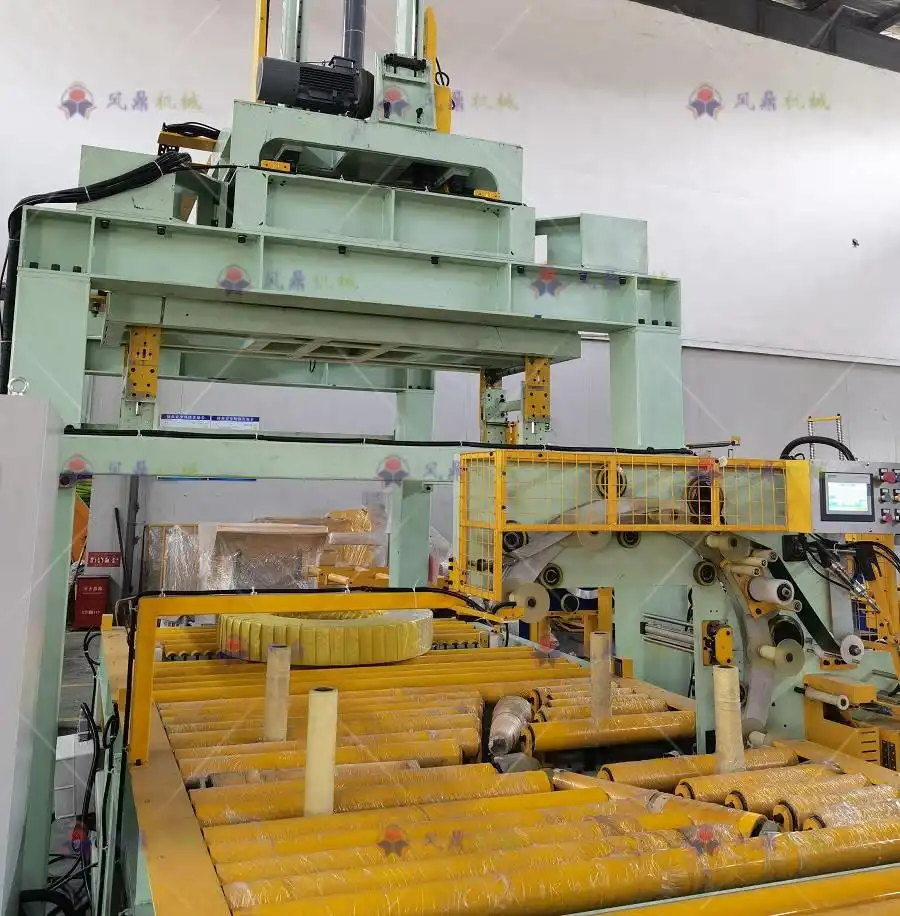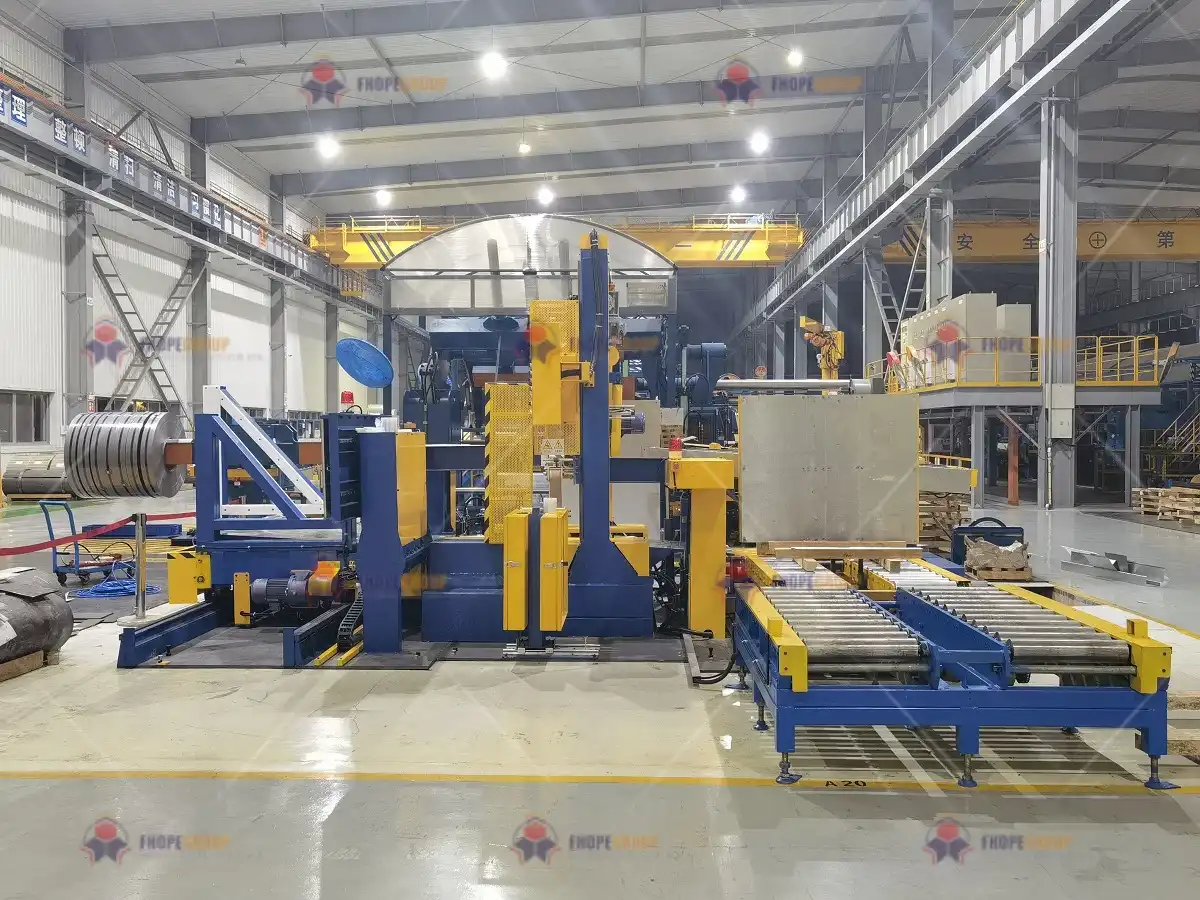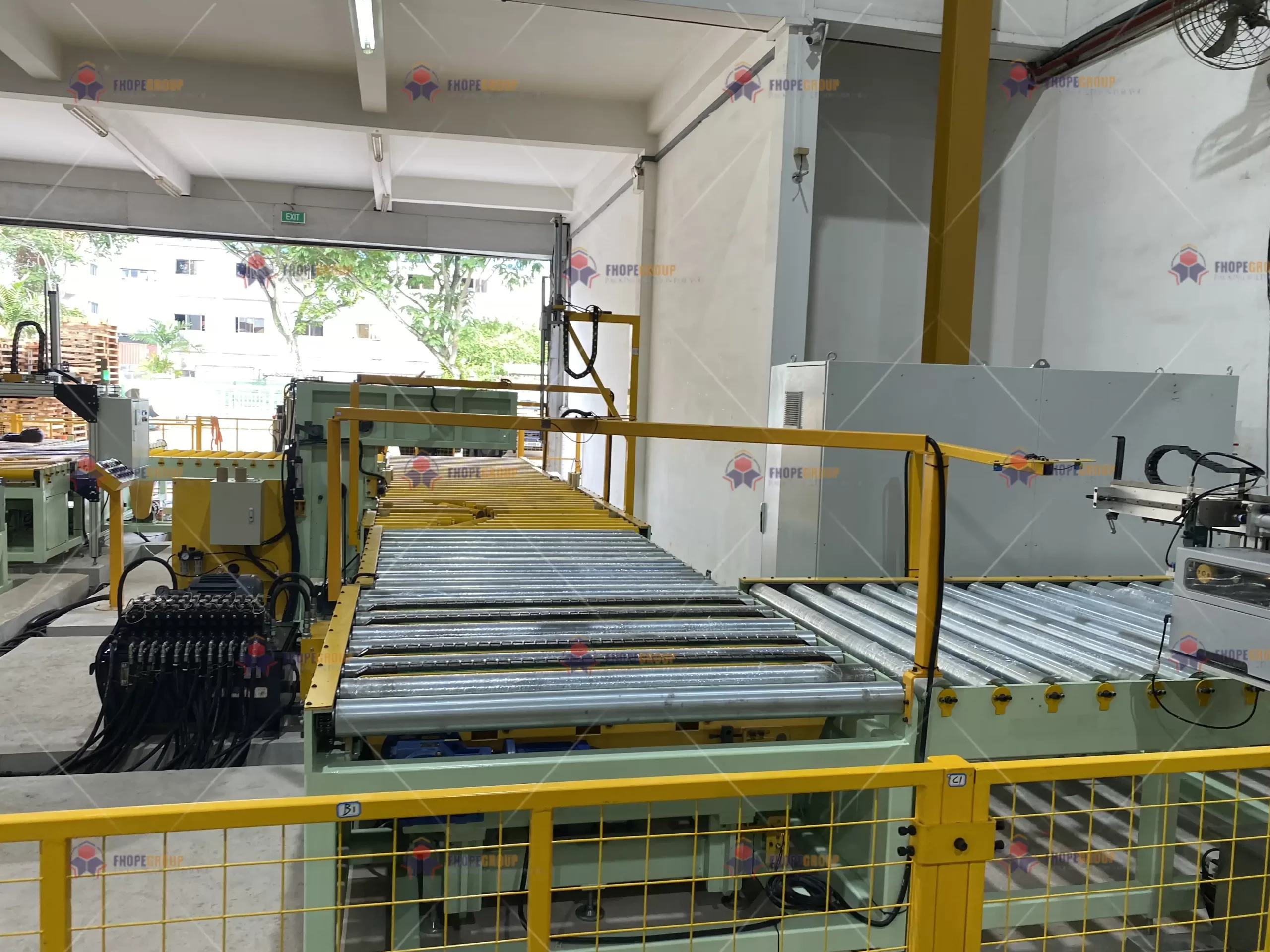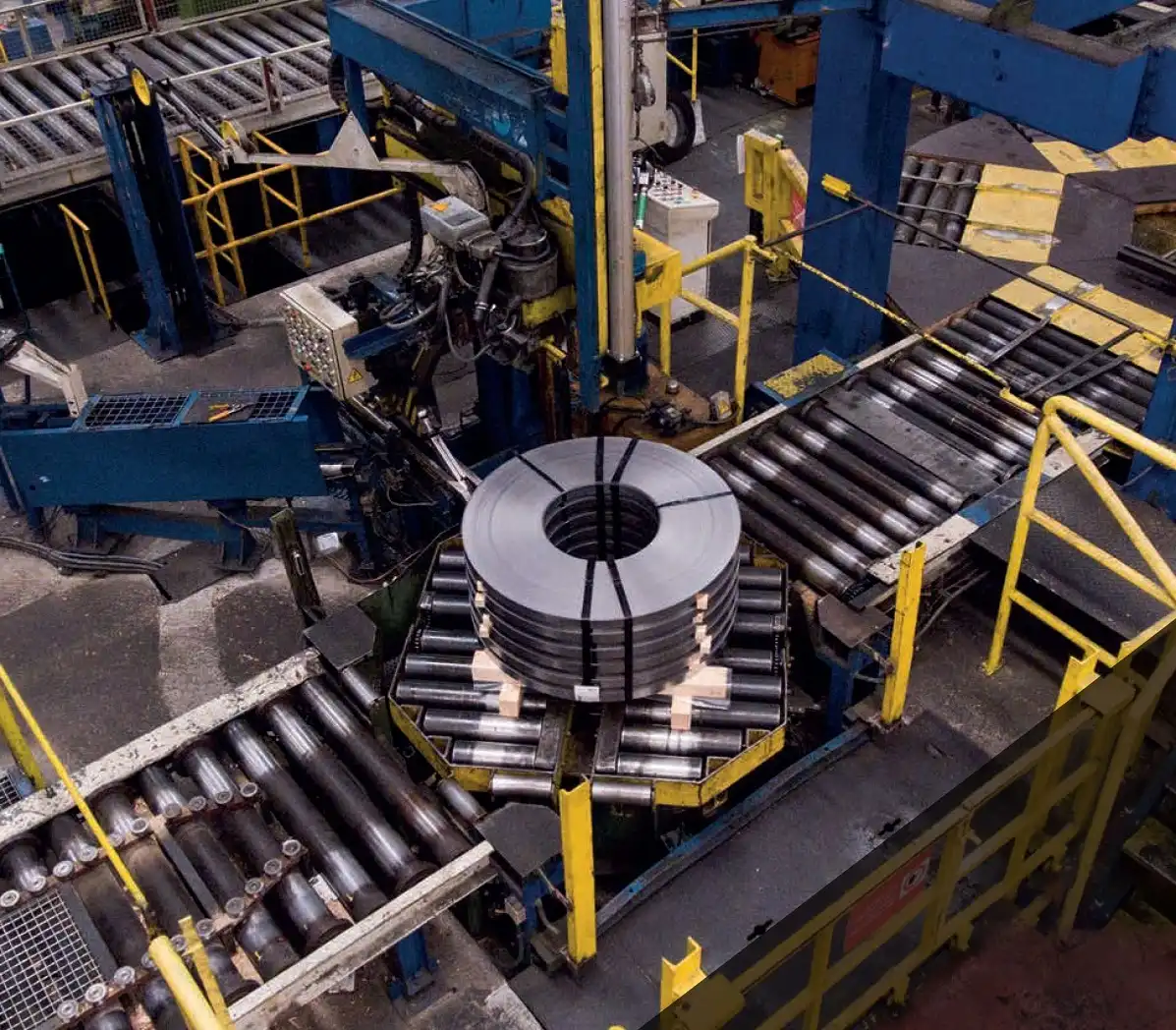Are you constantly battling bottlenecks at the end of your production line? I see it all the time in factories I visit. The manual packing process for steel coils is slow, it’s inefficient, and frankly, it’s dangerous. You're likely dealing with the constant worry of worker injuries from handling these heavy loads, which drives up your insurance costs and employee turnover. This chaos not only hurts your team's morale but also eats into your profits through product damage and delayed shipments. It feels like a problem with no easy solution. But I can tell you from my years on the factory floor that the answer isn't just a new machine; it's a smarter layout designed from the ground up, starting with the most basic facts about your product: its weight and size.
Coil mass and dimensions are the fundamental blueprints for designing an effective coil packing line. The mass of your coils dictates the structural integrity and power requirements for every component, from the turnstile to the conveyor. The dimensions, including width and diameter, determine the physical size of the machinery, the configuration of the conveyors, and the overall footprint of the line to ensure coils move smoothly and safely without damage.

This might sound like common sense. But in my experience, overlooking these core details is the number one reason why new packing lines fail to deliver on their promise. A layout that isn't perfectly matched to your coils' specific characteristics will create new problems instead of solving old ones. Let's dig deeper into how you can get this right from the very beginning.
How Do Heavy Coils Impact Your Equipment Choice and Foundation?
Do you look at your current equipment and wonder if it's truly up to the task of handling your heaviest coils, day in and day out? Many factory managers live with a low-level fear of a catastrophic failure—a conveyor collapsing or a tilter failing—that could bring production to a grinding halt and, worse, put their team in serious danger. This anxiety often stems from a past decision where equipment was chosen based on price rather than on the real-world demands of the job. The absolute starting point for every single equipment decision must be the maximum weight of the coils you need to handle.
Heavy coils demand machinery built with higher load capacities, more powerful motors, and fundamentally stronger, more robust construction. This principle applies to the entire line, including the coil car that receives the coil, the turnstile, the conveyors, the tilter, and the wrapping machine. Furthermore, your factory's concrete floor and foundation must be professionally assessed to confirm they can safely support the immense, concentrated weight of both the machinery and your heaviest coils.

Deeper Dive: Beyond the Machine's Frame
When we talk about handling heavy coils, it's about more than just a thicker steel frame. It's an entire system philosophy. I've seen factories try to save money by using equipment rated for just their average coil weight. This is a recipe for disaster. One unexpectedly heavy coil can cause irreversible damage or lead to premature wear and tear, resulting in constant downtime and repairs.
Matching Load Capacity to Your Heaviest Coil
The golden rule is simple: design for your maximum load, not your average. If your coils range from 5 to 15 tons, your entire line must be engineered to handle a 15-ton coil safely and repeatedly. This means looking closely at the specifications. For conveyors, it means using heavy-duty chains and sprockets, not standard-duty ones. For a tilter, it means a more powerful hydraulic system and stronger pivot points. Trying to get by with a 10-ton-rated system will eventually lead to failure. The stress on components accumulates over time, and what seems like a small saving upfront becomes a massive expense later in maintenance and lost production.
The Hidden Demands on Your Factory Floor
The machine is only half the equation. The floor it sits on is the other half. A 15-ton coil plus a 5-ton machine section equals 20 tons of focused pressure on one small area of your concrete. Is your floor slab thick enough? Does it have the right reinforcement? I worked with a client who installed a beautiful new packing line, only to discover cracks forming in their floor after just a few months. The cost to shut down the line, tear up the concrete, and pour a new, reinforced foundation was huge—a cost that could have been avoided with a proper geotechnical survey at the start.
| Feature | Standard-Duty (Up to 5 tons) | Heavy-Duty (5-20 tons) |
|---|---|---|
| Conveyor Chain | Standard roller chain (e.g., C2082) | Heavy-duty, double-pitch chain (e.g., C2122 or stronger) |
| Motor Power (Conveyor) | 1.5 - 2.2 kW | 3.0 - 5.5 kW or higher |
| Machine Frame | 6-8mm steel plate construction | 10-15mm+ reinforced steel plate |
| Tilter Mechanism | Lighter hydraulic cylinder, smaller pivot pins | Larger bore hydraulic system, hardened, oversized pins |
| Foundation Requirement | Standard 6-inch concrete floor often sufficient | 8-12 inch reinforced concrete pad may be required |
Remember, the mass of your coil is a force that tests every part of your system. Respecting that force in your design phase is the key to building a line that is not just efficient, but also safe and durable for years to come.
How Do Varying Coil Widths and Diameters Affect Your Line Design?
Does your packing line feel clumsy and inefficient because it's handling a wide range of coil sizes? Perhaps you're processing narrow slit coils one moment and wide master coils the next. This variation often leads to frustrating slowdowns, or worse, damaged product. A coil's edge can get scraped on a poorly designed conveyor, or a narrow coil can become unstable on a wide V-saddle. These are classic signs of a "one-size-fits-all" approach, which in reality, fits none of them well. To achieve true efficiency, your line must be designed with this dimensional flexibility in mind.
Varying coil dimensions, specifically width and outer diameter (OD), are critical factors that directly influence the physical design of your packing line. The conveyor system must be wide enough to safely handle your widest coil, yet feature adjustable guides or center-V designs to stabilize your narrowest coils. Critically, the wrapping station's shuttle ring must have an opening large enough to accommodate the maximum OD and width, ensuring a complete, protective wrap without any risk of collision or damage to the coil's edges.

Deeper Dive: Engineering for Flexibility
When I first started building packing lines, my focus was on pure strength. But I quickly learned from my clients that dimensional flexibility is just as important. A factory manager in the steel service industry once told me, "Vincent, your machine is strong, but it's damaging my narrow coils." That was a wake-up call. We had designed for his heaviest coil, but not his narrowest. It taught me that a successful design must account for the full range of product dimensions to prevent damage and maintain efficiency.
Designing Conveyors for All Sizes
The solution isn't just to make conveyors extra wide. While the overall width must accommodate the maximum coil width, the challenge is keeping smaller coils stable. A narrow coil can easily tip or slide on a wide, flat conveyor. This is where V-shaped saddles or powered rollers with a slight "V" profile become essential. They naturally center the coil. For lines handling an extreme range of widths, adjustable vertical guide rollers are a fantastic addition. They can be moved in or out depending on the coil being processed, providing lateral support and preventing any side-to-side movement that could cause surface scratches or edge damage. This is a small detail that makes a huge difference in product quality and reduces customer complaints.
The Wrapping Ring: A Critical Dimension
The heart of the packing line, the wrapping station, is highly sensitive to coil dimensions. The wrapping ring, which carries the film or paper, must be large enough for your biggest coil to pass through its center. If the OD of your coil is 2000mm, the inner diameter of your ring must be significantly larger to provide clearance. But it's not just about the OD. The shuttle that travels around the ring must be designed to handle the swing required for your widest coil. If the shuttle's travel is too short, it won't properly cover the corners of a wide coil, leaving them exposed.
| Design Element | Consideration for Narrow Coils (e.g., <300mm) | Consideration for Wide Coils (e.g., >1500mm) |
|---|---|---|
| Conveyor Type | V-Saddle or centered roller design for stability. | Flat-top heavy-duty chain with sufficient width. |
| Guiding System | Adjustable vertical guide rollers are critical. | Fixed, robust side guides may be sufficient. |
| Wrapping Station | Ensure wrapping material applies evenly without wrinkling. | Shuttle travel must be long enough to cover the entire face. |
| Stacking/Palletizing | Centering mechanism is crucial for stable stacking. | Requires robust pallet and secure strapping pattern. |
By thinking through these dimensional challenges, you move from a generic layout to a tailored solution. This attention to detail is what prevents product damage, reduces waste, and allows your packing line to run smoothly, no matter what size coil comes down the line.
What's the Best Way to Arrange Equipment to Maximize Throughput?
Do you ever look at your packing area and see organized chaos? Forklifts weaving through pedestrian areas, cranes waiting for clearance, and piles of coils creating dangerous and inefficient choke points. This kind of environment is a clear sign that the physical layout of the equipment is fighting against your production flow, not helping it. A poorly planned arrangement is one of the biggest hidden drains on productivity. The goal isn't just to connect machines; it's to create a seamless, logical, and safe path for every coil.
The optimal equipment arrangement for maximizing throughput is one that creates a clear, uninterrupted material flow from the production line's exit to the final storage area. For operations handling various coil sizes, this typically involves using turnstiles or transfer cars to direct coils to the appropriate packing or strapping stations. Most importantly, it requires placing buffer stations or accumulation conveyors strategically before the main packing machine to ensure it is never starved for product, allowing for a smooth, continuous pace.

Deeper Dive: Choreographing Your Material Flow
When I established my own packing machine factory, I became my own first customer. I had to think like an operations manager, not just an engineer. I learned that the space between the machines is just as important as the machines themselves. I spent weeks observing the flow, moving templates around on a large floor plan, trying to eliminate every wasted step and moment of hesitation. This is the essence of a good layout: making the journey of the coil as short and simple as possible.
Linear vs. U-Shaped vs. L-Shaped Layouts
There is no single "best" layout; the right choice depends on your floor space, existing infrastructure, and production flow.
- Linear (I-Shaped) Layout: This is the simplest layout, where the coil moves in a straight line from start to finish. It's easy to understand and manage but requires a long, narrow space. It's excellent for dedicated, high-volume production of similar-sized coils.
- L-Shaped Layout: This layout is useful when you have constraints on building length. The line turns 90 degrees, often using a turnstile or a right-angle transfer conveyor. It's great for separating processes, for instance, keeping the strapping area distinct from the wrapping area.
- U-Shaped Layout: This is often the most efficient layout for space. The entrance and exit of the packing line are near each other. This minimizes the travel distance for forklifts or overhead cranes loading and unloading the line. It also allows a single operator to potentially oversee multiple stages of the process.
The Power of Buffers and Turnstiles
In a plant that produces coils of different sizes and requires different packing recipes, a simple linear path isn't enough.
- Buffer Stations: Imagine your slitter produces a coil every 3 minutes, but the wrapping machine takes 4 minutes for a complex wrap. Without a buffer, the entire slitting line has to stop and wait. A buffer is simply a section of conveyor—often an accumulation conveyor—that can hold one or two coils. It decouples the two processes, allowing each to work at its own optimal pace.
- Turnstiles and Transfer Cars: These are like traffic controllers for your coils. A turnstile can receive a coil and rotate it 90 or 180 degrees to send it down a different path. A transfer car can move a coil laterally to a parallel line. This is essential if, for example, some coils only need strapping while others need both wrapping and strapping. It prevents coils that don't need a process from creating a queue and blocking those that do.
| Layout Type | Key Advantage | Best Suited For | Main Consideration |
|---|---|---|---|
| Linear (I-Shape) | Simple, clear flow. | High-volume, low-mix production. Long, narrow space required. | |
| L-Shape | Fits in corner spaces, separates processes. | Buildings with width/length constraints. | The corner transfer must be reliable. |
| U-Shape | Space-efficient, centralized operation. | Minimizing forklift travel, single-operator oversight. | Can feel congested if not planned well. |
A well-designed layout brings a sense of calm and order to the factory floor. It makes work safer for your team, reduces the chance of accidental damage, and, most importantly, allows your expensive machinery to run at the steady, predictable pace you invested in.
How Does Automating Coil Handling Justify Its Cost?
Do you hesitate when you see the price tag for a fully automated packing line? I understand. It's a significant capital investment. You know your manual processes are slow, risky, and costing you money, but you struggle to build a rock-solid business case that proves the return will be worth it. Many managers get stuck here because they only focus on one thing: replacing labor costs. The true justification for automation goes much, much deeper than that.
Automating the handling and packing of coils justifies its cost through a powerful and multifaceted Return on Investment (ROI). This ROI is calculated by combining direct savings from reduced labor with the significant financial gains from increased throughput, dramatically lower accident rates and insurance premiums, and the near-elimination of product damage caused by manual handling. The result isn't just a cost-saving measure; it's a strategic investment in a more profitable, reliable, and competitive operation.

Deeper Dive: Building an Undeniable Business Case for Automation
To a pragmatic manager, numbers speak louder than words. When I was running my factory, I couldn't make an investment unless I could prove to myself it would pay for itself and then make me money. It's not about spending; it's about investing. Helping my clients see this complete financial picture is one of the most important parts of my job. Let's break down how to build that case.
Calculating Your True ROI: Beyond Labor Costs
Labor savings are the easiest part to calculate, but often the smallest piece of the puzzle. Yes, if you can reassign three workers from the packing line, you save their salaries and benefits. But the real value comes from what the automation enables. An automated line can pack a coil in 2-3 minutes, consistently, all day long. A manual team might take 10-15 minutes, and their speed will vary. If you can ship 20% more product every day with the same number of production staff, that's a massive increase in revenue. That's the number that really gets attention. Furthermore, automation eliminates the costs associated with product damage from forklift tines, improper handling, or dropping a coil. Track those costs for a few months—you'll be surprised how much they add up.
Safety Improvements: A Return You Can't Ignore
How do you put a price on preventing a serious injury? It's difficult, but the financial impact is very real. A single major workplace accident can lead to devastating direct costs (medical bills, compensation) and indirect costs (production shutdown, investigation time, increased insurance premiums for years to come, and damage to employee morale). Automation removes your team from the most dangerous tasks: lifting, turning, and manipulating heavy coils. This fundamentally changes your risk profile. When you present your case, include a section on risk reduction and potential insurance savings. It shows you are thinking about the long-term health of the business and its people.
| ROI Component | Manual Process Cost (Example/Year) | Automated Process Savings (Example/Year) |
|---|---|---|
| Direct Labor | 3 workers x $40,000 = $120,000 | $120,000 |
| Product Damage | 1% of $5M revenue = $50,000 | Savings of $45,000 (assuming 90% reduction) |
| Lost Production (Downtime) | 2 hours/week x 50 weeks x $500/hr = $50,000 | Savings of $40,000 (assuming 80% reduction) |
| Workplace Accident Costs | Average $5,000 (insurance, etc.) | Savings of $5,000 (near elimination of risk) |
| Increased Throughput | N/A | 15% more output = $750,000 additional revenue |
| Total Annual Value | ($225,000 in costs) | $960,000 in savings and new revenue |
This table is just an example, but it shows how the conversation shifts. You're no longer asking for money to solve a problem. You're presenting a clear, data-backed plan to make the company significantly more profitable and secure. That's a proposal that gets approved.
My Insight: Why Your Supplier's Experience Is Your Biggest Asset
Have you ever been in a meeting with a supplier and had the sinking feeling that you, the factory manager, knew more about your own operational challenges than the salesperson across the table? They present a slick brochure for a machine, but they can't answer your detailed questions about material flow, integration, or maintenance. This is the risk of dealing with a supplier who just sells equipment. They provide a product, but not a true solution.
A supplier's real-world, hands-on experience is your single biggest asset because designing a great packing line is about more than just connecting machines. An experienced partner—someone who has actually run a factory and faced the same pressures you do—understands the hidden complexities of throughput, safety, and workflow. They can anticipate problems you haven't even thought of yet and design a holistic solution that avoids costly mistakes and works for your business in the long run.
Deeper Dive: A Partnership, Not a Purchase Order
I didn't start my career as a business owner. I started as an engineer on the factory floor. I spent years getting my hands dirty, troubleshooting machines, and dealing with the frustrations of production bottlenecks. Later, when I built my own packing machine factory, I faced the same challenges every one of my clients faces: controlling costs, ensuring quality, and keeping my team safe. That journey, from employee to engineer to factory owner, gave me a perspective that can't be learned from a catalog. It's the reason I founded SHJLPACK.
From Factory Floor to Factory Owner: A Different Perspective
My experience taught me that the "perfect" machine on paper can be a nightmare in reality if it's not integrated properly into the surrounding workflow. I learned that a few extra feet of conveyor used as a buffer can be the difference between a smooth operation and constant stop-starts. I learned that the position of a control panel can drastically affect an operator's efficiency and safety. These are things that "sales-only" suppliers often miss. They see the machine as the solution. I see the entire process as the solution, and the machine is just one part of it. This perspective allowed me to build a successful business and achieve financial independence, not just by building good machines, but by building smart, efficient systems.
What "Sales-Only" Suppliers Don't See
A supplier focused purely on the sale will ask you, "What machine do you want to buy?" An experienced partner will ask, "What is the problem you are trying to solve?" They will want to understand your coil dimensions, your mass, your production rate, your building layout, and your safety concerns. They don't just sell you a wrapping machine; they help you design the most efficient and cost-effective way to get your coil from the slitter to the shipping truck. They act as a consultant, using their experience to protect you from common pitfalls. This is the difference between buying a tool and hiring an expert.
My gratitude for what this industry has given me is the driving force behind SHJLPACK. I'm not here just to sell another machine. I'm here to share the knowledge I gained over decades of hard work. My mission is to act as a knowledge-sharing platform, to be a partner you can trust, and to provide solutions that I know, from my own experience, will truly help your business grow.
Conclusion
A packing line layout tailored to your specific coil mass and dimensions is not a luxury; it is a fundamental investment in your factory's long-term efficiency, safety, and profitability.





